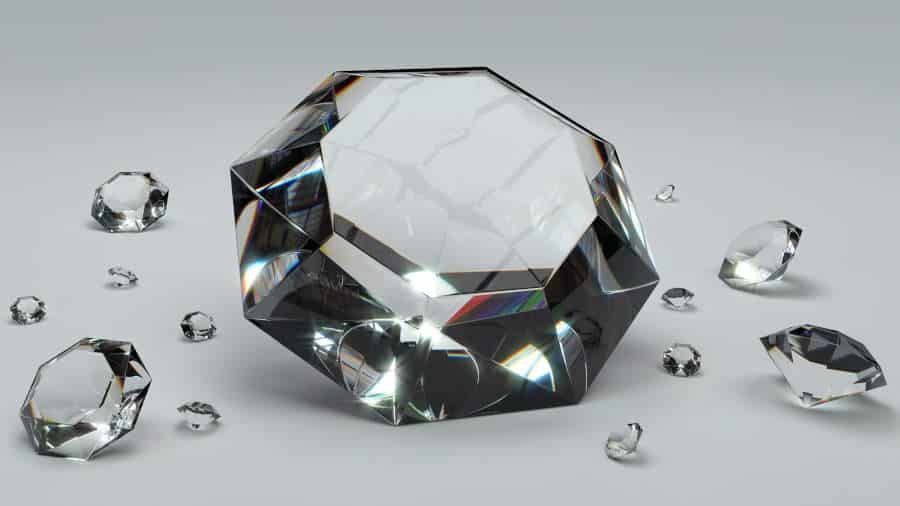Diamonds are found deep underground, below the earth crust, they occur at around 100miles below the earth’s surface. They are used industrially for making grinding, cutting, drilling and polishing tools; they are also used in making priced jewelries. Diamonds possess certain unique properties that make them special. Some of the physical properties of diamonds include:
- They are hard
- They have high refractive index
- They have brilliant luster
- They exist as crystals
- They exist in different colors
- They do not conduct electricity.
- They cannot dissolve in acid and organic solvents
- They do not burn easily; and
- They are warm to touch
Diamonds are hard
Diamond is the hardest known natural material on earth. It is so hard that only another diamond can cut or scratch it. Diamonds are hard due to their very compact crystalline molecular structures. They are made up of carbon atoms held together by covalent bond in a lattice structure. Each of the carbon atoms is bonded to four other carbon atoms to form a tetrahedral unit. Some parts of a diamond are harder than other parts; they are harder in the directions where atoms are held together tightly. The hardness of diamond is measured using a Mohs scale. On the Mohs scale diamonds score 10, which is the highest level of hardness a material can have. Diamond is so hard that it is about 40 times harder than those materials scoring 9 on the Mohs scale.
Diamonds have high refractive index
Light moves slower in vacuum than in diamond. Refractive index is measure of how much a beam of light bends when passing through a material. Diamond has a higher refractive index than many naturally occurring gemstones i.e. when light passes through diamond it bends a great deal compared to how much it bends passing through other gemstones.
Diamonds have brilliant luster
Diamonds have good light transmission properties; they are able to reflect light radiantly. This is reflected in their high refractive index and transparent to translucent nature. Diamond is said to have an adamantine luster- this is the best kind of luster a material can have to greasy luster- although, rough diamonds have greasy luster.
Diamonds exists as crystals
Diamonds exist in crystalline form. Their crystals may be translucent, transparent or opaque and are either octahedral, dodecahedral or hexahedral in shape. They also exist as microcrystalline masses, as in Carbonado. Carbons can also be irregular in shape like in many black diamonds
They exist in different colors
Colorless diamond is the most popular color form of diamond. It is the purest and structurally perfect form of diamond and is mainly used in the production of priced jewels. Other colors in which diamonds exists include yellow (pale to deep yellow), white, blue (blue white to deep blue), grey, black and shades of oranges, pinks, reds, and green. Chemical impurities accounts for the color of some diamonds i.e. a diamond having a color rather than being colorless may be an indication that an element other than diamond (carbon) is present in the diamond.
Diamonds do not conduct electricity
For any material to act as a conductor for the flow of electricity, it must have electrons that are freely moving. Electrons in carbon are tightly packed, they do not move freely hence carbon cannot conduct electricity- you cannot be electrocuted through diamond.
Diamonds cannot dissolve in acids and organic solvents
Diamonds do not dissolve in acids or other organic solvents like alcohol, but when in contact with hot steel, diamond dissolves irreversibly.
Diamonds do not burn easily
Diamonds are made up of carbon and like every other form of carbon, they burn. Despite being the hardest natural substance on earth, carbon can burn in heat in the presence of pure oxygen gas or liquid oxygen. When diamond burns, it vanishes into non-existence.

Diamonds are warm to touch
A method of identifying real diamond from a fake one is by bringing it in contact with the body, most diamond simulants feel cool to touch, but diamonds are generally warm to touch. This is because they warm up when in contact with the body. Diamonds feeling warm to touch are due to two reasons: their (1) low specific heat and (2) high thermal conductivity.
SPECIFIC HEAT OF DIAMOND
The specific heat of a material is that property of the material that determines the amount of heat the material can hold. The specific heat of diamond is low unlike in most solids. The low specific heat capacity of diamond can be attributed to its extreme hardness, which makes the bonds between the carbon atoms in it very strong. Another reason for the low specific heat of diamond is their low-density. This means diamonds would have high frequency lattice vibration. Most materials used for making jewelries have higher specific heat than diamond.
THERMAL CONDUCTIVITY OF DIAMOND
Thermal conductivity of a material refers to how much a material can conduct heat. Naturally, materials with high thermal conductivity conduct heat more than those with lower thermal conductivity. When diamonds come in contact with the body (or any surface at all) they draw heat from the body that is why they feel warm to touch. The thermal conductivity of diamonds greatly depends on its purity. For instance, at temperatures of 100K a pure synthetic diamond of 99.9% has a thermal conductivity of 41,000Wm-1K-1, while a natural diamond of 98.9% purity may have a much lesser thermal conductivity of 10,000 (which is also a very high thermal conductivity). This means the purer the diamond the warmer it is to touch, although this is negligible because all diamonds feel warm to touch and you may not be able to decipher the difference in their degree of warmness. Diamond has a far higher thermal conductivity that of other gemstones. Due to diamond’s high thermal conductivity it is used in making electronic devices as heat extractors.
In summary, diamonds feel warm to touch due to their low specific heat and high thermal conductivity.

